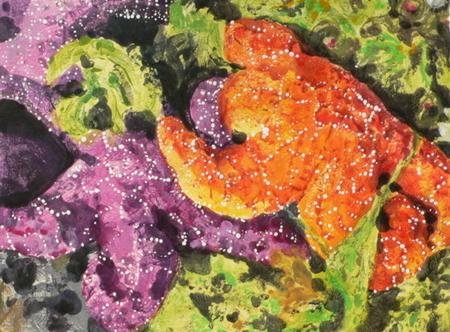This month, Horsley Printmakers' Carol Nunan of Carol's Original Prints has requested that printmakers post a "how to" on their blog about monotypes in May. So I thought I'd take her up on her suggestion (a little early, whatever!). If you're a printmaker and want to do the same, make sure to link back to Carol's blog and send her a comment on her post so that she knows to add your link to her list.
Here's a clip from my website talking about monotypes:
These terms [monotype and monoprint] are often used interchangably; however, I like to think of them as completely different techniques. Both printmaking techniques result in a "one-off" image; you can never repeat that image. Some people have difficulty understanding how this can be a print if only one is produced, but it is the method of production that makes it a print. Probably the best description of the differentiation between these two techniques can be found in Monotype - Mediums and Methods for Painterly Printmaking by Julia Ayres:
"...the term monotype is used for work developed on top of an unaltered plate, utilizing its flat surface, while monoprint refers to monotype work that also includes elements of another printmaking process such as etching, woodcut, lithography, silk screen, and so on."I use either watercolour or acrylic paints to produce monotypes. I paint onto frosted Mylar, and while the paint is still wet, I make the transfer by laying a registered sheet of paper over the Mylar and pressing gently by hand on the back of that paper. I repeat the process until I've completed the image. There is another method whereby you prepare the surface of the plate so that you can paint the image in its entirety, leave the paint to dry, then use a moistened sheet of paper to lift the image. I find this method more restrictive, but many artists prefer it because there is an added level of control to how the printed image will turn out.(Watson-Guptill Publications, New York, 1991, page 8)
OK, so that's a basic outline of how I do it. The above print Embrace was created by painting acrylic onto frosted Mylar and transferring to the registered paper while the acrylic was still wet (i.e. really fast!).
I have my original sketch taped down to a surface, then I tape the Mylar (frosted-side up to paint on) on top of the sketch. I hinge the paper I'd like to print on usually along the longest side. This print was printed on a really heavy hot-pressed watercolour paper (I think Fabriano), and I quite like that surface & weight for doing the acrylic monotypes. I started with the lightest colours first (e.g. light yellow, light green), and work quickly, painting the acrylic on the Mylar then transfer the paint to the paper by flipping the hinged paper down on top of the Mylar and burnishing the back of the paper with my hand. I keep doing that repeatedly until I've got the final image I'd like. This sometimes requires that I let some layers dry a little first, but with acrylics, that doesn't take long at all.
Here are some other images that I've done that way:
As you can see, the results of monotypes can be extremely painterly. I remember my mother, upon being introduced to monotypes, thinking to herself "If I'm going to paint it, why on earth would I go to the trouble of the double work of painting then printing?!?" Then she tried it and discovered the textures that you can achieve only through the transference of paint from the plate to the paper support. You can't get those textures any other way: the surface tension breaking between the plate & paper makes for some wonderful textures that wouldn't occur right off your paint brush.
I do the same process with watercolours; however, I find the acrylics are easier to build bolder, brighter colours with. Here's a monoprint that started with a watercolour monotype to get the colours, then a block print on top for the black part:
This "working wet" technique, of course, is not the only way to make monotypes; it's just the way that I have discovered that I prefer. Here are a (very!) few other printmakers who use monotypes to create their work:
Bruce Waldman
Lori Dean-Dyment
Heather Aston
Thanks Carol, what a great idea. I look forward to seeing what other printmakers send you!











5 comments:
Thanks for the info, Amie! I haven't done a monoprint in years, and I keep saying I'm going to do it. This weekend!
I love Promise of Spring. I find monoprints captivating. If I get started on them again I won't quit! ;->
Amie,
Thanks for mentioning me in this great post on monotypes. I've never done monotypes with the mylar like you had described. Sounds really interesting and I think I may try it.
Thanks! Your blog gave me the info I needed - plus getting me excited about trying the technique! Thank you for the photo examples.
Thanks! Your blog gave me all the basic info I needed, and also got me excited about trying the technique!
Post a Comment